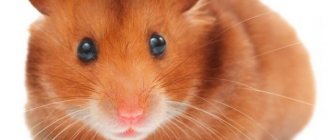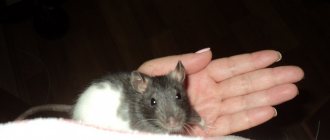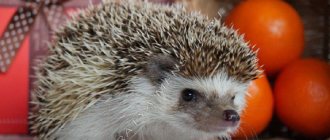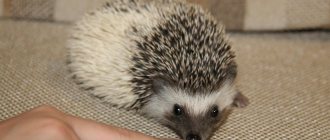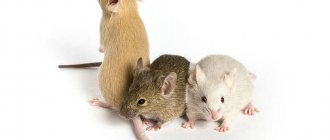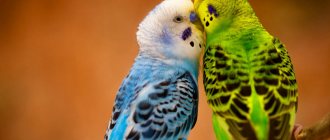Let's start with a couple of lines of encyclopedic information. Do you want to know where your animal comes from and what it is like? And then we’ll immediately talk about caring for Syrian hamsters.
One of the cutest pets.
Syrian hamsters (aka royal, golden, golden) were first mentioned in the 18th century, but a scientific description appeared only in 1836. They were discovered near Aleppo (Syria), which is why they got their name. After this, the rodent was considered extinct for a long time, because The stubborn Syrian hamster did not show itself to the researchers.
The cunning Syrian, foreseeing the future of toys for children and laboratory “consumables” (joke), migrated to the territories of modern Israel, Turkey, Iran, the Balkans, where he still lives safely.
The Syrian hamster hid for almost 100 years, and in 1930, an Israeli zoologist discovered a female with 12 hamsters. Only 4 survived, but this was enough for the rodent to become one of the most popular pets in our time.
Description
The largest among their relatives. The average body length of an adult is 12-15 cm, sometimes up to 19-20 cm. The weight of males is 100-125 g, females 115-140 g. Large individuals can reach a weight of 200 g. The color of the fur can be different, as well as its length. The abdomen and lower part of the neck are usually lighter in color.
Appearance
The animal has a dense body, a short muzzle and legs, medium round ears and small black beady eyes. Tail 7-10 mm. It is almost invisible due to its thick fur. The hind legs are weaker than the front legs. They have 5 fingers. The strong and tenacious forelegs also have 5 toes, but only 4 of them are developed, and instead of the fifth, only its rudiment is different.
Colors
According to the international rating system, the following colors are divided into:
- golden;
- cream;
- white or ivory;
- smoky;
- yellow or yellow-brown;
- honey;
- tortoiseshell;
- agouti.
Character and habits
The character is friendly and flexible. The animals are inquisitive, but cautious, so they are frightened by sharp and loud sounds. They are mobile and active. They are nocturnal.
Lifespan
In the wild, age is limited to 1.5-2 years. It is impossible to definitively answer how long Syrian hamsters live in captivity. On average it is 3 years. The age can be increased to 4 years or more with proper care.
Types of fur of the royal rodent
There are 3 main varieties of Syrian hamsters based on their coat type.
Satin . Classic shorthaired Syrians. Often the coat is "glossy", which makes the hamster shine in the light.
Long-haired . A detachment of royal rodents with long hair (individuals with a hairstyle 8-10 cm long are known). Often these Syrian hamsters are also called Angora or Persian. The abundant coat requires special care, so we have dedicated separate material on the website to Angora pets.
And I'm not the shaggiest yet!
Rex. Bred relatively recently, they are covered with thick wavy hair that looks like curls.
Pros and cons of content
Keeping these cute rodents has its positive and negative sides.
The advantages of such a neighborhood include:
- small area occupied by the cell;
- low cost of the animal;
- unpretentiousness in food;
- disease resistance;
- easy care.
The disadvantages of the content include:
- short lifespan;
- specific smell;
- The animal makes noise at night.
Is the pet suitable for a small child?
Most often, it is children who ask to buy a hamster. You should not immediately refuse your child. But we must take into account an important point. The hamster will enter the child’s life for a fairly short period of time. His death can be traumatic for a young child. It is better to buy an animal for older children 7-8 years old. Pay attention to the Syrian breed; its representatives sometimes live even 7 years.
Singles or need neighbors
If you want to buy several hamsters, you need to know that each one will need its own individual cage. While affectionate and funny with their owners, they treat their own kind completely differently. Being territorial animals, these rodents will fight for territory and compete to the last, and if the weaker one has nowhere to go to hide from the wrath of an opponent, he will be killed.
Staying together is possible only for a few minutes during mating, naturally, under the supervision of an adult, responsible person who is able to recognize and react if a romantic date has turned into a fight, and to seat the unsuccessful couple.
If there are many questions about keeping hamsters in the same apartment with predators, then proximity to fish - minorcas, cockerels, guppies, laliuses, astronotuses, platies, barbs, gouramis, veiltails - will not harm anyone.
The rest of the time it is unacceptable to keep hamsters in a common cage.
Buying a pet
When choosing an animal, be sure to pay attention to its behavior and appearance.
Number of pets
The animal carefully guards its territory and does not tolerate the presence of strangers. When purchasing several rodents, each will need a personal cage.
Where to buy, price
The cost of a pet will depend on its color, place of purchase and region of your residence.
Where can you buy a hamster and how much will it cost?
- At the poultry market or from hand. The cheapest option. Price 100-300 rub. If you're lucky, an unwanted or unexpected offspring can be given away for free into good hands.
- Purchase at a pet store. Price 300-500 rub.
- Purchase from a nursery. Price 400-1000 rub. This is the most expensive option, but you will get a pet with a pedigree.
In addition to the cost of purchasing a pet, you will also have to spend money on a finished cage with everything you need, food and filler. This is still from 3500 rubles.
What to look for
Be sure to pay attention to the following indicators:
- fatness;
- active behavior;
- excessive aggressiveness (perhaps he has such a character);
- the coat is shiny and thick;
- absence of discharge from the eyes and nose;
- the area around the anus is dry;
- age (2-3 months is best, a young animal is easier to tame).
How to find out age and gender
Young hamsters are very active, curious and love to eat. Old people may even sacrifice food in favor of sleep. Juveniles can be distinguished by the thin light fur on their ears. Dull eyes indicate old age. This may also be an indicator of the disease.
Until 5 days the hamster has practically no fur. By 15 days, wool does not grow everywhere. Young fur has a bright color. If there are bald patches on it, then the animal is up to 1 month old. By 3 months, the animal’s weight will be no more than 40 g. The weight of an adult is 110-120 g.
To determine the sex of a hamster, you need to take it by the scruff of the neck and lift it. He will stretch his body and spread his legs to the sides. The difference between a female and a male is expressed in the distance from the anus to the genitals. In females it is about 3 mm, and in males it is 10-15 mm.
How to name
There are virtually no restrictions on choosing your pet's name. It can be selected according to the following principles.
- coat color (Ryzhik, Snowball, Black, Gray, Marshmallow, Sunny), you can refer to dictionaries not only of Russian and English (Schwartz, Bianka);
- character (Sonya, Shusha, Fugitive);
- physique and appearance (Donut, Fluffy);
- in honor of their idols (Angelina, Lolita, Johnny);
- according to the hamster’s taste preferences (Carrot, Potato);
- nickname in human style (Senya, Filya, Timka).
Meeting a furry animal
The Syrian hamster is a rodent belonging to the hamster family. Its other name is “golden hamster”, which it received due to its reddish-yellow fur. Animals of this breed can be colored not only golden, but also white, brown, black, and silver. The classic Syrian hamster is short-haired, but currently long-haired variations of this species have also been bred. The length of the body of Syrian hamsters ranges from 13 to 18 cm, weight fluctuates around 100-200 g.
The rodent's body is stocky, its legs are short, its ears are rounded, its muzzle is short, its eyes resemble convex beads, and it has a short tail, which is not easy to find in the thick fur. The abdomen is lighter than the back, like all rodents. The hind feet have five toes, the front feet have four, and there is also a rudimentary fifth. A distinctive feature of hamsters is their cheek pouches; the Syrian breed also has them, and it uses them fully. The active phase of an animal’s life in nature occurs at night.
Before getting any pet - be it a turtle, snail, rabbit, jerboa, degu, guinea pig, siskin, crossbill, parrot - you should study the features of caring for it.
The animals are clean and hardy. They are active, funny and curious, become attached to their owner and can be trained, and do not show aggression towards people. Females have virtually no scent, but males prefer to carefully mark their territory.
First described in the late 18th century, the Syrian hamster has a long, fascinating and intricate history of distribution, breeding, study and selection.
Did you know? The Syrian hamster was listed in the Red Book as an endangered species.
Preparing conditions of detention
Proper care cannot be carried out without preparing the habitat. The animal must be protected from stress and noise.
External conditions
During the day, the cage should be placed where there is practically no one, but preferably in plain sight. You need to find a place away from the TV and other devices. The room should be ventilated, but without drafts. Bright daylight will damage the animal's vision. The cage cannot be left on the windows. Content temperature 12-25°C. Its location near batteries or heaters is unacceptable.
Cage requirements
You should choose a spacious cage with vertical metal bars. The distance between them is no more than 10 mm. The optimal size is 60x40x25 cm. If it has several floors, then the distance between them is at least 30 cm. It is most convenient to clean the cage with a removable tray. It is recommended to cover the lattice bottom with cardboard or plexiglass. There should be no gaps between the cage door and its walls to prevent the pet from running away.
The rodent can be kept in a plastic or glass aquarium. This option eliminates the scattering of filler. But it is difficult to clean and poorly ventilated.
Litter
It is better to choose bedding from medium-sized wood sawdust. The layer thickness is at least 2 cm, the hamster will dig holes. Do not use improvised materials, such as newspapers or toilet paper, as a base layer.
Toilet
It is better to take a litter tray with a removable lid. It can be triangular or square in shape. The filler can be the same material as for the bedding or a special one.
You can make a toilet with your own hands. To do this you need:
- take a plastic container with a lid;
- cut a round hole at a height of 2.5 cm from the floor level;
- treat the edges of the hole so that the hamster does not get hurt.
You can use glass instead of plastic. It is enough to take an ordinary glass jar with a wide opening. A 500 ml container will do. Such a toilet must be well secured so that it does not roll around on the floor of the cage.
Wheel and manholes, tunnels
During the night, the animal can run more than 10 kilometers around the cage. Tunnels, manholes and a running wheel will help increase the space for movement.
A running wheel must be chosen with a diameter of 18 cm or more. It can be attached to the wall of the cage or stand on the floor. It is better that the wheel is also attached to the floor. It is important to choose a trainer made from the right material that will not cause your hamster’s legs to break.
The best option would be:
- wooden;
- plastic;
- from a fine mesh.
Manholes are constructed from roots, branches, and tubes. Wood should be chosen that is healthy and treated with special compounds.
You can buy a cage with tunnels or purchase sections separately and assemble the structures yourself. It's easy to make a tunnel with your own hands.
Basic materials that are suitable for this work:
- plastic bottles with a volume of at least 2 liters;
- plumbing pipes.
Holiday house
The hamster will sleep in the house and hide from noise. He can make a nest for himself inside. To do this, you need to put shavings, pieces of paper, and shreds in the cage.
The house can be:
- made of plastic;
- made of wood;
- made of ceramics;
- from wicker or plant fibers;
- from fabric.
Feeder
For this purpose, it is better to take a ceramic bowl with a stable bottom. The plastic version is too light. The hamster will constantly turn the plate over.
Drinking bowl
The drinking bowl is attached to the outside of the cage, and the part intended for drinking goes inside. Volume 20-50 ml. It is undesirable to use a saucer; water will fall on the litter, which promotes the proliferation of pathogenic microbes.
How to weigh a hamster?
To weigh this tiny creature you will need:
- kitchen scales;
- cardboard or plastic box;
- seeds or nuts;
- the hamster himself.
First you need to weigh the box itself with several seeds, then put the animal there and use the subtraction method to determine the weight of the animal itself.
The seeds are needed so that the hamster is occupied with them for the time required for weighing, otherwise the fidget may run away.
Reasons for changes in hamster weight
Feeding
It is very important to know what you can feed your hamster and what you cannot. A nutritious and balanced diet will allow him to live an active and long healthy life.
Feeding principles
Feed 2 times a day. In the morning they give less food than in the evening. The required amount of food varies depending on age. The best option is to have some food left in the bowl in the morning. Greens and twigs should be washed thoroughly. It is better to collect them away from roads. Vegetables and fruits must be cleaned of rotten areas.
Basic diet
A balanced diet for a Syrian rodent should contain:
- cereals;
- plant food;
- protein food.
From grains you can give wheat, corn, peas, buckwheat, sesame. You can buy a ready-made mixture at a pet store. Green food includes clover, plantain, burdock, lettuce, parsley, dill, and hay. Dandelion and wormwood should be given with caution. Branches of apple, cherry, maple, oak, poplar, and birch are cut.
Syrian hamsters' favorite vegetables are carrots and cucumbers. You can give pumpkin pulp, radishes, turnips, zucchini, and sweet peppers.
Chicken and quail eggs, boiled chicken breast, low-fat cottage cheese, insects and worms sold in pet stores will help fill the need for protein foods.
Supplements
As a supplement to the main diet, you can give watermelon, pumpkin, and melon seeds. Berries in small quantities will also be useful. Strawberries, wild strawberries, raspberries, and seedless grapes are allowed.
Treats
Sweet fruits and nuts can lead to excess weight and diabetes, so they should be given with caution. Hamsters love sunflower seeds, peanuts, apples, peaches, and bananas. Seeds and pits must be removed from fruits.
Prohibited Products
Even though hamsters are considered omnivores, many foods can be harmful to them. Such foods include citrus fruits, cabbage, berry and fruit seeds, bread, canned food, bird food, pine needles, sorrel, sea buckthorn, dairy products, lard.
Watering
Clean water at room temperature is a must. It must be updated every day, even if the pet has not drunk.
Features of feeding elderly hamsters
At the age of 2 years, the hamster's diet needs to be changed. The animal becomes less active and eats less. The hamster needs to grind solid food and wipe vegetables. It is necessary to add vitamins to food.
How long do they live?
The average lifespan of a pet hamster is two to three years. This applies to healthy, well-cared for animals. In the wild they rarely manage to live that long. A case has been officially recorded in which a Syrian hamster died at the age of 7 years.
Factors that affect your pet's lifespan:
- quality of care;
- genes;
- feeding;
- availability of simulators;
- living environment;
- diseases.
Important! By caring for a furry animal, you prolong its life.
Care
Caring for your Syrian hamster and its home is necessary regularly. This will avoid unpleasant odors in the apartment and preserve the health of the pet.
Cleaning the cage
The cage needs to be cleaned approximately once every 5 days. The hamster is removed from the cage. The litter changes as it gets dirty. The food bowl and drinking bowl are washed daily. To disinfect, you can pour boiling water over them. You can use special disinfectant compounds for cleaning; it is better not to use household chemicals.
Is it possible to bathe a hamster
Bathing is highly undesirable for hamsters. If it gets dirty, you can wipe it with a damp cloth.
If you can’t avoid swimming, you need to adhere to the following rules:
- warm water;
- the head and muzzle should remain dry when bathing;
- After bathing, dry the coat with a hairdryer.
Grooming
To clean the hamster's skin, you need to place a tray with disinfected dry sand. He will do this himself. The owner only needs to periodically comb the pet’s fur.
Claws
Sometimes overgrown claws cause discomfort to the animal. They can be trimmed with a nail clipper or tweezers. The very tips of the claws are treated. It is better to accustom the animal to this procedure from a young age.
Teeth
Rodents' teeth grow throughout their lives. To prevent them from growing too large, it is necessary to give the rodent various treats and toys that will help wear them off. As a last resort, you can contact a veterinarian.
Colors of Syrian hamsters
The original color of the Syrians is golden (reddish-red, sometimes called peach). But now Syrian hamsters have been bred to come in almost any color. List of main colors of Syrian rodents:
- White (sometimes snow white is distinguished separately)
- Beige
- Yellow
- Smoked
- Copper
- Sable
- Black chocolate
- Grey
Classic color.
Training and games
Animals can and should be trained. It is very important to try to toilet train him.
In order for the animal to get used to going to the litter box, you need to:
- Give the animal time to choose a specific place where it will usually defecate.
- Place a tray in this corner and fill it with filler. First, the new filler must be mixed with the old one.
- Keep an eye on the animal if it does not go into the litter box yet. Not everyone starts using the litter box right away; sometimes it takes a little longer.
- After the hamster has used the litter box for the first time, continue to pour the litter mixed with the old litter into it for about another week. Each time the proportion of pure composition should be larger.
Under no circumstances should you punish a pet if it does not go to the litter box right away. There is also no need to rush into taming him to the toilet; first you need to properly tame him to his new owners.
How to tame
It is best to start taming an animal at a young age. First, the hamster needs to get used to its new home. When he gets used to it, he starts running around the cage, spinning the wheel, you can begin to accustom him to holding hands. For the first time, you need to pick up the baby very carefully so as not to hurt him or drop him. Be sure to interact with your pet a little every day. To improve relationships, you can use pieces of fruit or seeds.
Walking around the apartment
Walking around the apartment can be very dangerous for a hamster. He can pick up something on the floor and eat it, chew through wires and get an electric shock, get underfoot or be slammed by a door. It is best to walk the animal around the apartment in a walking ball or make a special pen with toys.
Active games
The best active entertainment for a hamster is a labyrinth. You can assemble it from a large cardboard box, making cardboard walls inside and cutting passages in them. To make it more interesting for your hamster to explore the maze, you can place pieces of your favorite treat in several places.
How to quickly catch a runaway pet
If an escape from a hamster cage is detected, the premises must be isolated. Close the toilet lid, remove accessible harmful substances and mousetraps. Try not to make noise and carefully examine your surroundings. Sometimes it can take more than one day to look for an escaped hamster.
To shorten the process, you can use the following methods:
- leave a handful of food in each room, where it will be eaten and the animal is located;
- if the approximate location of the hamster is discovered, place an open cage nearby with fresh food and water;
- put the running wheel on, hearing its noise, the animal will definitely look out of its hiding place, and you will have time to carefully approach the fugitive;
- place the food on pieces of foil, its rustling will give you a sign;
- surround the laid out food with a ring of flour, in the morning you can follow the footprints of the pet's paws to find a new shelter for your pet.
Important Warnings
If your hamster squeaks or hisses, it means he is excited or scared. If this type of behavior occurs, the animal should be left alone.
It is worth protecting your pet from any items containing harmful impregnations, flavors and dyes. This is due to the habit of rodents to taste almost all surrounding objects.
You can only let your hamster go for a walk on the floor. Its natural habitat is plains. Animals often fall from vertical surfaces, which leads to injuries and fractures, so you should not leave your pet on a table or chair.
Taking care of your health
Has good immunity. Diseases arise mainly due to improper care. Small and old individuals are most susceptible to diseases. Most people get sick due to stress.
Major diseases
The most common diseases:
- cold;
- clogged or damaged cheek pouches;
- diarrhea;
- conjunctivitis;
- skin diseases.
The following symptoms should alert the owner:
- lethargy;
- manifestations of aggression;
- formation of wounds on the skin;
- photophobia;
- hard breath;
- hair loss.
With timely consultation with a doctor, most diseases can be cured.
Prevention
Timely treatment of the cage and bedding, a balanced diet, absence of drafts and stressful situations.
Reproduction
Pregnancy lasts 16-19 days. At one time, the female brings from 6 to 12 babies.
Mating
Males and females meet only during mating. The process must be under the control of the owner. The female must be in heat. The first mating is carried out for hamsters aged 4-6 months.
Caring for a pregnant female
The cage should be located away from drafts and excess noise. It is extremely undesirable to scare the expectant mother. You need to let the animal out for a walk several times a day. Clean the cage only when absolutely necessary. 4-5 days before birth, wash and disinfect the cage. Make bedding from fine hay.
The female's diet changes. Access to food and water must be available around the clock. Glucose can be added to water. It is necessary to introduce a lot of greens, cottage cheese, and boiled eggs into the diet. The feeding rate increases in the first days of pregnancy by 1/3, in the last days by 2 times.
Caring for newborn offspring
The room temperature should be between 21 and 25°C. Newborn hamsters should not be picked up. For the first few days, their mother takes care of the hamsters, so it’s better not to disturb her, but to pay attention to caring for her herself. The female and the babies need privacy and peace.
Choosing a place to place the house
It is necessary to locate the hamster's cage in a quiet place, excluding loud sounds and sudden noises, since rodents experience stress that has a detrimental effect on the body. Do not place your pet's house in direct sunlight or place the rodent in the kitchen space, as excessively high temperatures will also negatively affect the pet's well-being. In favorable conditions, hamsters will be able to maintain health until old age, which overtakes them after 2-3 years of life. By the way, if the pet belongs to children, try to correctly explain to them the age of the pet, preparing them for further separation, avoiding false hopes for the animal’s endless cheerfulness and existence.


